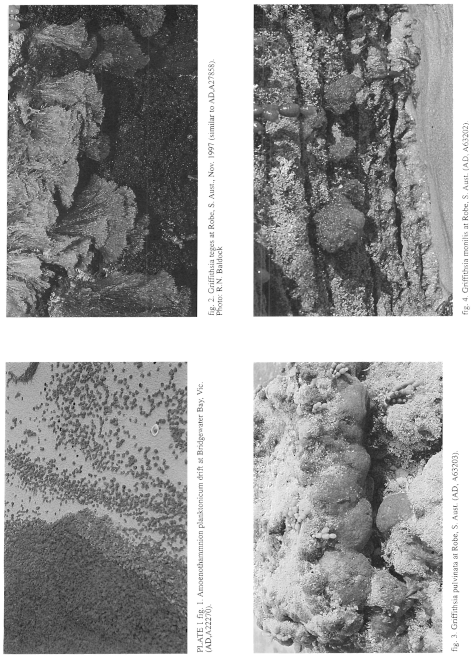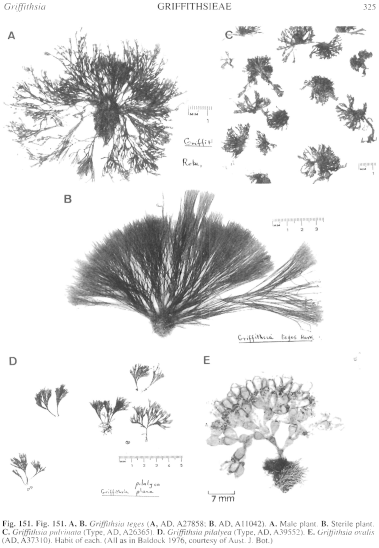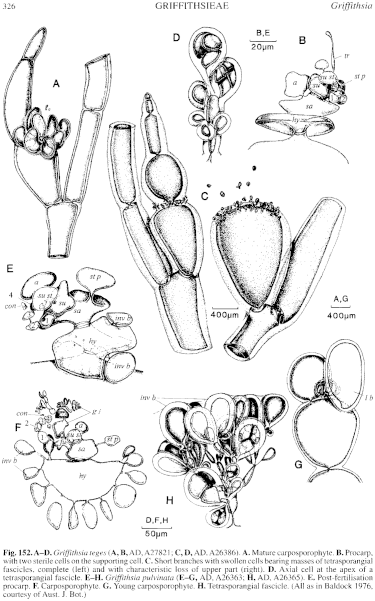|
|
|
|
|
|||||||||||
|
Electronic Flora of South Australia Species Fact Sheet
Phylum Rhodophyta – Order Ceramiales – Family Ceramiaceae – Tribe Griffithsieae
Selected citations: J. Agardh 1876: 70; 1885: 5, fig. 2d-g. Baldock 1976: 541, figs 40–43, 84, 85. De Toni 1903: 1284. Huisman & Walker 1990: 423. Lucas 1909: 48. Silva et al. 1996: 413. Sonder 1881: 11. Tisdall 1898: 502. Wilson 1892: 186.
Synonym
Griffithsia antarctica Hooker & Harvey sensu Harvey 1859b: 332. Sonder 1881: 11. Bornetia antarctica sensu Lucas 1909: 48; 1929a: 24.
Thallus (Pl. 1 fig. 2; Fig. 151A, B) dark red, coarse, 2.5–17 (–20) cm high; eulittoral plants stiff and sometimes erect, forming extensive mats with filaments more or less adpressed, deeper plants more openly branched, irregularly subdichotomous. Attachment by a wad of twisted and anastomosing rhizoids from cells near the thallus base; epilithic. Structure. Filaments gradually attenuate towards obtuse apices, slightly constricted at the nodes, loosely clothed with rhizoids below. Cells cylindrical to doliform, 0.4–0.8 mm in diameter and L/D 2–4.
Reproduction: Gametophytes dioecious. Female axis 3-celled, flanked by 2 pairs of minute hair-like synchronic laterals, subapical but displaced laterally by continued growth of the apical cell. Procarp systems (Fig. 152B) subapical, each with a sterile lateral cell and supporting cell bearing 1 (–2) sterile cells apically and 1 (–2) lateral, recurved carpogonial branches of 4 cells; hypogenous cell producing abaxially 6–10 two-celled involucral branches; the sub hypogenous cell swollen towards its upper end (Fig. 152A). Post-fertilisation fusion cell columnar, bearing 1–3 gonimolobes terminally, most cells of which become ovoid (-clavate) carposporangia, 40–65 µm in diameter. Spermatangia borne on numerous, minute fascicles clustered in the constrictions between swollen, obovoid and globose cells 750–1250 µm in diameter at the base of a short lateral branch 3–6 cells in length, similar in appearance to those associated with tetrasporangial clusters (see Fig. 152C); filaments including globose cells above fascicles often caducous, so that mature fascicles appear terminal on the basal ovoid cells which become 880–1500 µm in diameter; fascicles initially polychotomous, later laterally branched; involucral cells absent.
Tetrasporangia borne on numerous minute fascicles in the constrictions between ovoid and globose cells at the base of short laterals (Fig. 152C) with the upper cells often caducous; in volucre absent. Fascicles producing clusters (Fig. 152D) of 2–6 lachrimi form tetrasporangia 46–88 µm in diameter.
Type from W. Aust. (probably near Fremantle) (Harvey); the holotype (Harvey, Tray. Set 146) is missing from TCD; lectotype (Baldock 1976, p. 541) Harvey Alg. Aust. Exsicc. 496A.
Selected specimens: Point Peron, W. Aust., upper sublittoral reef pools (Mitchell, 22.ix.1966; AD, A30780). Esperance, W. Aust. (Gordon, 21.xi.1968; AD, A33948). Point Sinclair, S. Aust., shallow pools (Womersley, 8.ii.1954; AD, A19627). Elliston, S. Aust., 3–4 m deep (Shepherd, 22.x.1970; AD, A37524). Price I., off Point Avoid, S. Aust., 21 m deep (Branden, 6.i.1989; AD A59972). Cape Donington, S.Aust., 3–9 m deep (Shepley, 23.0.1959; AD, A22321). Port Stanvac, S. Aust., 2–4 m deep on jetty piles (Lewis, 24.0.1972 ; AD, A41301). Port Noarlunga, S. Aust., 1.5 m deep, (Kald, 3.xii.1966; AD, A30981). Chiton Rocks, Victor Harbor, S. Aust., 6 m deep (Clarke, 22.iv.1978, AD, A59018). Pennington Bay, Kangaroo I., S. Aust., on Hormosira in the upper sublittoral (Baldock, 19.i.1965; AD A28616). Robe, S. Aust., upper sublittoral-lower littoral on rock (Baldock, 25.v.1963; AD, A26386, 19.v.1964; AD, A27821 and 18.v.1964; AD, A27836) and (Womersley, 20.iv.1969; AD, A34080), upper sublittoral shaded region (Baldock, 18.v.1964; AD, A27858), and pool near jetty (Womersley, 27.viii.1949; AD, A11042) and (Womersley, 11.xii.1969; AD, A34878-"Marine Algae of Southern Australia" No. 107). Lawrence Rock, Portland, Vic. (Beauglehole, 15.i.1960; AD, A24762). Port Phillip Bay, Vic., (Macpherson, 3.v.1963; AD, A28828) and drift, San Remo Ocean Beach, Vic. (Sinkora A1997, 27.xi.1974–5.xii.1974; AD, A54224). Crawfish Rock, Westernport Bay, Vic., 5m deep in strong current (Shepherd, 31.i.1970; AD, A35228). Erith I., Bass Strait,Tasmania, 10 m deep (Shepherd & Lewis, 10.v.1974; AD, A45111)
Distribution: Fremantle, W. Aust. to Wilsons Prom., Victoria and Bass Strait.
Taxonomic notes: G. teges is a ubiquitous and common species growing in coarse mat-like strata from the lower eulittoral-upper sublittoral, on jetty piles and rock, and to a depth of 21 m, generally on rough-water coasts.
In vegetative features G. teges closely resembles G. antarctica from sub-antarctic regions, and sterile plants can be confused with this species; G. teges usually produces a wad of rhizoids at the thallus base and eulittoral plants grow in coarse clumps and mats, whereas in G. antarctica branching is more open and few rhizoids are produced. Reproductively, G. teges resembles G. antarctica Hooker & Harvey in that masses of spermatangial and tetrasporangial fascicles lack involucral cells.
References:
AGARDH, J.G. (1876). Species Genera et Ordines Algarum. Vol. 3, Part 1- Epicrisis systematic Floridearum, pp. i-vii, 1–724. (Weigel: Leipzig.)
AGARDH, J.G. (1885). Till algernes systematik. VII. Florideae. Acta Univ. lund. 21, 1–120, Plate 1.
BALDOCK, R.N. (1976). The Griffithsieae group of the Ceramiaceae (Rhodophyta) and its southern Australian representatives. Aust. J. Bot. 24, 509–593.
DE TONI, G.B. (1903). Sylloge Algarum omnium hucusque Cognitarum. Vol. 4. Florideae. Sect. 3, pp. 775–1521 + 1523–1525. (Padua.)
HARVEY, W.H. (1855a). Some account of the marine botany of the colony of Western Australia. Trans. R. Jr. Acad. 22, 525–566.
HARVEY, W.H. (1859b). Algae. In Hooker, J.D., The Botany of the Antarctic Voyage. III. Flora Tasmaniae. Vol. II, pp. 282–343, Plates 185–196. (Reeve: London.)
HARVEY, W.H. (1863). Phycologia Australica. Vol. 5, Plates 241–300, synop., pp. i-lxxiii. (Reeve: London.)
HUISMAN, J.M. & WALKER, D.I. (1990). A catalogue of the marine plants of Rottnest Island, Western Australia, with notes on their distribution and biogeography. Kingia 1, 349–459.
LUCAS, A.H.S. (1909). Revised list of the Fucoideae and Florideae of Australia. Proc. Linn. Soc. N.S.W. 34, 9–60.
LUCAS, A.H.S. (1929a). The marine algae of Tasmania. Pap. Proc. R. Soc. Tasm. 1928, 6–27.
SILVA, P.C., BASSON, P.W. & MOE, R.L. (1996). Catalogue of the Benthic Marine Algae of the Indian Ocean. (University of California Press: Berkeley, Los Angeles & London.)
SONDER, O.W. (1881). In Mueller, F., Fragmenta Phytographiae Australiae. Supplementum ad volumen undecinum: Algae Australianae hactenus cognitae, pp. 1–42, 105–107. (Melbourne.)
TISDALL, H.T. (1898). The algae of Victoria. Rep. 7th Meet. Aust. Ass. Adv. Sci., Sydney, 1898, pp. 493–516.
WILSON, J.B. (1892). Catalogue of algae collected at or near Port Phillip Heads and Western Port. Proc. R. Soc. Vict. 4, 157–190.
The Marine Benthic Flora of Southern Australia Part IIIC complete list of references.
Publication:
Womersley, H.B.S. (24 December, 1998)
The Marine Benthic Flora of Southern Australia
Rhodophyta. Part IIIC. Ceramiales – Ceramiaceae, Dasyaceae
©State Herbarium of South Australia, Government of South Australia
Illustrations in Womersley Part IIIA, 1998: PLATE 1 fig. 2; FIGS 151A, B, 152 A–D.

Plate 1 enlarge
PLATE 1 fig. 1. Amoenothamnion planktonium drift at Bridgewater Bay, Vic. (AD, A22270).
fig. 2. Griffithsia teges at Robe, S. Aust., Nov. 1997 (similar to Ad, A27858). Photo: R.N. Baldock.
fig. 3. Griffithsia pulvinata at Robe, S. Aust. (AD, A63203).
fig. 4. Griffithsia monilis at Robe, S. Aust. (AD, A63202)

Figure 151 enlarge
Fig. 151. A, B. Griffithsia teges (A, AD, A27858; B, AD, A 11042). A. Male plant. B. Sterile plant. C. Griffithsia pulvinata (Type, AD, A26365). D. Griffithsia pilalyea (Type, AD, A39552). E. Griffithsia ovalis (AD, A37310). Habit of each. (All as in Baldock 1976, courtesy of Aust. J. Bot.)

Figure 152 enlarge
Fig. 152. A–D. Griffithsia teges (A, B, AD, A27821; C, D, AD, A26386). A. Mature carposporophyte. B. Procarp, with two sterile cells on the supporting cell. C. Short branches with swollen cells bearing masses of tetrasporangial fascicles, complete (left) and with characteristic loss of upper part (right). D. Axial cell at the apex of a tetrasporangial fascicle. E–H. Griffithsia pulvinata (E–G, AD, A26363; H, AD, A26365). E. Post-fertilisation procarp. F. Carposporophyte. G. Young carposporophyte. H. Tetrasporangial fascicle. (All as in Baldock 1976, courtesy of Aust. J. Bot.)

|
Email Contact: State Herbarium of South Australia |

|